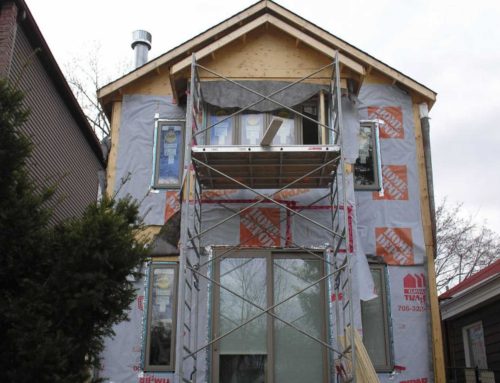When a fierce storm rolls in, bringing with it heavy rain, driving snow, or powerful winds, a home’s exterior is put to the ultimate test. While many homeowners might think of their roof first, the home’s primary line of defence against this horizontal assault is its siding. This outer layer acts as a suit of armour for the walls, shielding the vulnerable structure within from the harshest elements. However, this armour is only one part of a complete defensive system. A high-quality siding installation works in a critical partnership with the roof to create a seamless, weatherproof envelope. Neglecting either component can leave a home exposed, which is why a trusted roofing company will always consider the health of the entire exterior. This guide will explore how this dynamic duo protects your home from harsh weather and why their synergy is key to long-term structural integrity.
More Than a Pretty Face: Siding as Your Home’s Armor
Siding’s most fundamental role is to be the primary barrier against direct weather impact. It is the home’s raincoat, engineered to shed water, block wind, and deflect hail. This protects the sensitive structural materials of the walls. Beneath the siding lies the sheathing. This layer is typically made of a wood composite material, which is highly susceptible to moisture damage. Properly installed siding ensures this sheathing stays dry. This prevents the slow, silent process of wood rot that can compromise the wall’s strength over time. This protective function is the first and most critical job of any siding.
Beyond preventing structural decay, siding plays a crucial role in a home’s energy efficiency. It does this by protecting the insulation within the walls. When moisture penetrates the wall cavity, it soaks the insulation. This causes it to compress and lose its insulating properties, or R-value. This leads to significant heat loss in the winter and heat gain in the summer. As a result, the HVAC system is forced to work harder, driving up utility bills. Trapped moisture in the insulation also creates the perfect breeding ground for mould and mildew, which can severely impact indoor air quality.
A Top-Down Approach: The Roof and Siding Partnership
While siding guards the vertical surfaces, the roof manages the massive, top-down assault of precipitation. A sturdy, well-maintained roofing system funnels thousands of litres of water into the gutters and safely away from the house. A roof with proper overhangs and correctly installed flashing is the first and most important water-diversion tool. It significantly reduces the amount of water that ever comes into contact with the siding. This allows the siding to focus on its primary job: defending against wind-driven, horizontal moisture.
This synergy between the roof and siding can be compared to a suit of armour. The roof is the helmet, deflecting overhead blows. The siding is the breastplate, protecting the core from direct attacks. A failure in one component puts immense pressure on the other. For instance, a clogged gutter will cause water to overflow. This water then cascades down the walls, constantly soaking the siding. Even the best siding will eventually fail under this persistent assault. This can lead to leaks that begin at the roofline but manifest as wall damage.
Nature’s Test: Wind, Water, and Winter’s Wrath
In Canada, wind-driven rain is a common and insidious threat. Strong winds can push water sideways with incredible force. This drives moisture into the tiniest cracks, seams, and gaps in poorly installed siding. Once inside the wall system, this water becomes trapped between the siding and the sheathing. This area is not designed to dry out quickly. As a result, the trapped moisture can lead to hidden rot, sheathing delamination, and a slow degradation of the wall’s structural integrity. This is why a seamless and well-maintained siding installation is so critical.
The destructive freeze-thaw cycle is another major risk factor for Canadian homes. Water that finds its way behind siding panels can freeze during the cold winter months. As water freezes, it expands by about 9% with immense force, which can pry the siding panels away from the wall, pop nails, and create larger gaps for even more water to enter during the next thaw. Some porous siding materials can also absorb moisture, which then freezes and causes the material itself to crack, chip, or spall. This is why choosing a material engineered for our climate is key, as durable siding protects your home long-term.
Built to Last: The Importance of Material and Craftsmanship
The choice of siding material is a crucial decision that impacts both a home’s durability and its long-term aesthetic. Modern materials like vinyl, fibre cement, and engineered wood are specifically designed to withstand the challenges of a Canadian climate. They offer excellent resistance to cracking in extreme cold and are stabilized to prevent warping during summer heatwaves. Furthermore, their advanced coating technologies provide superior UV protection. This is a key consideration when selecting siding materials for fade-resistance, as it ensures the home’s colour remains vibrant for decades, preserving its curb appeal.
However, even the best siding material will fail if it is not installed correctly. Professional installation is paramount to creating a truly weatherproof barrier. This includes the proper application of a weather-resistant barrier, or house wrap, which acts as a secondary line of defence. It also involves using the correct nailing patterns that allow the siding to expand and contract with temperature changes without buckling. Finally, it requires meticulous flashing around all windows, doors, and other penetrations to create a seamless, integrated seal that leaves no entry point for water.
A Stitch in Time: The Value of Proactive Maintenance
To ensure a home’s exterior remains in peak condition, a proactive maintenance plan is essential. A semi-annual visual inspection, ideally in the spring and fall, is the best way to catch small issues before they become big problems. During this walk-around, look for any signs of damage, such as cracks, chips, warping, or loose panels. Also, check the caulking around windows and doors to ensure it is intact and not pulling away from the frame. A gentle annual cleaning with a soft brush, a mild detergent, and a garden hose can remove built-up dirt and prevent mildew growth, which can trap moisture against the surface.
This maintenance routine should extend to the entire home envelope, particularly the roofing system. It is critical to keep gutters clean and free of debris to prevent overflows that can saturate and damage the siding below. A quick visual check of the roof’s flashing and the seals around vents and chimneys can confirm that the top of the system is just as secure as the sides. This holistic approach to maintenance not only protects the home’s structure but also shows a pride of ownership that helps to increase your home’s resale value.
The Dynamic Duo of Defence
In conclusion, siding and roofing are not separate entities but a single, codependent team working to protect your home. The siding acts as the primary shield for the walls, defending against the direct assault of harsh weather, such as wind, rain, and snow. The roof, in turn, manages the massive volume of water from above, reducing the burden on the siding and directing moisture safely away. When high-quality materials are professionally installed and proactively maintained, this dynamic duo creates an impenetrable, weather-resistant fortress. This comprehensive approach is the key to protecting your property’s value, ensuring your family’s long-term comfort, and building a home that truly stands strong against the elements.






